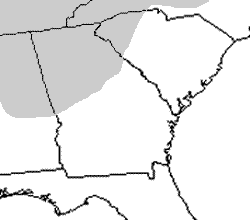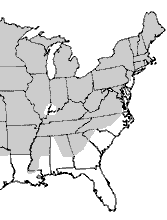American Toad (Anaxyrus americanus)
American Toad (Anaxyrus americanus)
![bufame210 American Toad (Bufo [Anaxyrus] americanus)](https://srelherp.uga.edu/wp-content/uploads/sites/70/2024/01/bufame210.jpg)


Description: A medium-sized toad, 51–90 mm (2.0–3.5 in) in length, with dry, warty skin and variable coloration. Dorsal color is typically brown or gray, but may also be reddish, olive, or tan, often with yellow or tan patches and irregular dark spots. Usually, one or two warts occur within each of the largest dorsal spots, with enlarged warts present on the tibia. A distinct light stripe runs along the middorsal. The venter is pale with numerous dark markings. Behind each eye is a swollen parotid gland, and the postorbital ridges are separated from the parotoids but often linked by a short spur. Males are smaller than females and develop dark throats during the breeding season. Two subspecies occur: the eastern American toad (A. a. americanus) and the dwarf American toad (A. a. charlesmithi). Hybridization is common with Fowler’s and southern toads where their ranges overlap.
Distribution and Habitat: The most widely distributed North American bufonid, found throughout the eastern United States and Canada, excluding most of Florida. Range extends from eastern Manitoba and Quebec to the Maritime Provinces and south through the Midwest, Northeast, and Southeast, reaching east Kansas, the Dakotas, Oklahoma, and Texas. Occupies diverse terrestrial habitats, including deciduous and mixed forests, fields, pastures, and residential areas, provided leaf litter, sandy or loamy soils, moist refuges, and abundant prey are available. Breeding occurs in shallow, fish-free waters such as temporary ponds, roadside ditches, or lake margins.
Reproduction and Development: Breeding season begins as early as January–February in the Southeast, extending from March to July across most of the range. Males form choruses, calling primarily at night with a long, high-pitched, musical trill (“bu-r-r-r-r”) lasting 6–30 seconds. Females deposit 2,000–20,000 eggs in double gelatinous strands, attached to vegetation or on the substrate. Eggs hatch within 3–12 days. Tadpoles metamorphose into toadlets in 1–2 months, reaching reproductive maturity at 2–3 years.
Habits: Primarily nocturnal, American toads remain inactive during hot, dry periods and overwinter underground. They occupy small home ranges but may travel over 0.5 miles to breeding sites. Known for hiding spot fidelity. Diet consists of small invertebrates (ants, beetles, moths, earthworms), while tadpoles feed on algae, detritus, and occasionally carrion or conspecifics. Predators include snakes, birds, and mammals; some species tolerate or are immune to their toxic skin secretions. Defense strategies include cryptic coloration, body inflation, and secretion of bufotoxins from parotoid glands. Eggs are toxic, but toxicity is reduced during the larval stage. Tadpoles often swim in dense schools for protection, though vulnerable to predatory insects, crayfish, and wading birds.
Conservation Status: Listed as Least Concern by the IUCN, owing to its broad range, large populations, and tolerance of a wide range of habitats, including disturbed environments.
![bufame3 American Toad (Bufo [Anaxyrus] americanus)](https://srelherp.uga.edu/wp-content/uploads/sites/70/2024/01/bufame3.jpg)
![bufame2 American Toad (Bufo [Anaxyrus] americanus)](https://srelherp.uga.edu/wp-content/uploads/sites/70/2024/01/bufame2.jpg)
